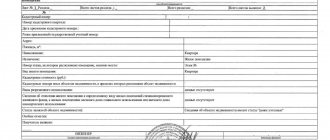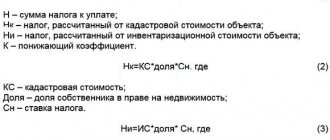Types of technical inventory
There are three types of inventory:
| View | Time spending |
| Primary | Required only for new objects or those for which such a procedure was not carried out for some reason, and they are not included in the relevant register. |
| Unscheduled | It is carried out after redevelopment or reconstruction, as well as during the reconstruction of a building, the construction of additional premises or structures, or the dismantling of any parts. Required before concluding a transaction for the alienation of rights to real estate. |
| Planned | Carried out every 5 years to identify discrepancies. This period was not chosen by chance. According to statistics, it is after the specified period of time that changes are made. Read also the article: → “Types of inventory in accounting.” |
Grounds and purposes of inventory
Technical control of real estate pursues the following goals:
- identification of complete, objective and reliable information about the property. Such information is needed not only by government agencies, but also by owners;
- creation of a unified database including all real estate. This goal is aimed at systematizing information, as well as improving the layout of the area;
- collection and transmission of data to statistical authorities;
- checking the completeness and accuracy of the information necessary for the correct calculation of property tax;
- collection and transfer of information to registration authorities.
The procedure is important due to the fact that the data obtained is used in the work of other services and departments; on their basis, taxes are calculated, depreciation is determined, insurance is carried out, and the amount of other payments is established. Inspection of a property is carried out in several cases:
- construction of a new facility;
- major renovation of the building;
- in relation to an unfinished construction project when registering rights to it;
- performing legally significant actions, the object of which is real estate. These include the allocation of a share in common property, its alienation, mergers and other transactions.
The initiator of the inventory is the owner of the building or premises. State bodies submit applications in the prescribed manner, citizens draw up an application by personally appearing at the territorial department or multifunctional center.
Technical inventory and technical accounting
The inventory process is defined as a type of accounting activity. It is characterized by a set of accounting work, with the introduction of changes made to real estate in the technical documentation.
The subsequent inventory and inclusion of buildings or plots in the list provide for a comparative analysis of conditions, in kind and in the documentation compiled during the technical accounting of the previous inventory.
Accounting - identifying the existing characteristics of objects, compiling a list of real estate on this basis.
The main thing for him is reconciliation and comparison of data, regulated by inventory purposes. And also – entering objects into the inventory.
The goals of the inventory are different; they fit within the framework of obtaining information about the resource of the Housing Fund and the property structure of non-residential premises intended for production or commercial activities.
The result of the process is an assessment of the final value of the property, taking into account depreciation, which allows for a decrease in value, or taking into account reconstruction and improvement, which allows for improved characteristics and increased value.
The functions of the TI are as follows:
- collection and processing of information;
- assignment of inventory and cadastral numbers;
- generation and issuance of documentation;
- its storage and preparation for scheduled work;
- determining the value of real estate.
Real estate objects subject to inventory
Inventory can only be carried out in relation to a property as an independent accounting unit with autonomous characteristics and corresponding legal status. A building or premises is classified as such if it has a technical passport, plan and explication, as well as a cadastral number.
Sometimes complexes that include several real estate objects are taken as a unit of accounting. In this case, they are included in the list, and other additional premises are considered as auxiliary characteristics. Various elements or premises located in a building are also not separate objects, as are those structures that do not fall under the definition of a capital structure. All of them are accepted as characteristics of the main structure.
Inventory is carried out in relation to all real estate objects, both residential, industrial and other purposes.
Residential buildings include multi-storey and individual houses, dormitories. Among non-residential buildings we can distinguish buildings with administrative or public purposes, garages, summer houses and other buildings. If the structure was erected in the absence of a properly executed building permit, then an inventory can also be carried out, since the presence of this document does not affect the result of the technical inspection of the property.
In addition, the inventory can be carried out in relation to hydraulic facilities (platforms, ponds, piers), linear structures (gas wells, electrical networks, power plants, substations), transport facilities (railways and roads), cultural, including religious buildings. Read also the article: → “Inventory of work in progress and deferred expenses: in construction and production, procedure, posting, order.”
Objects of technical inventory of real estate
The objects subject to reconciliation are accounting units that have autonomous characteristics and independent legal status in the form of a name, which determines the admissibility of their inclusion in the inventory.
The main criterion determining the legal status of a property eligible for the designated procedure is considered:
- technical passport of the building;
- technical plan with explication;
- cadastral number.
Other situations provide for the definition of an accounting unit or object to include several buildings that make up a single complex.
The complexes that make up the accounting unit are included in the list, and the set of premises that organize its structure are counted as auxiliary characteristics of the object.
If a complex structure needs to be divided into two or three units, accompanying documentation is drawn up, and a dividing line is drawn between the buildings in the form of a fence or a blank wall that does not allow direct communication. Conditional divisions are not allowed.
Responsible entities for conducting inventory
The inventory is kept in the records of the Technical Inventory Bureau. This institution has a branched structure of territorial divisions, each of which is assigned to certain areas of the administrative unit. BTI archives store technical information about all real estate objects.
Among the powers of the BTI is to carry out an inventory at the request of the owner of the property for a fee established by law.
In their activities, the bureau and its territorial divisions interact with other services and departments. Among them: Rosreestr, housing and communal services, housing departments, departments supervising urban planning, local administrations, land management committees.
BTI documents for premises - what are they?
These are mandatory documents prepared by the Bureau of Technical Inventory to maintain mandatory records of buildings and structures.
Documents for the premises are necessary for carrying out transactions with real estate, requiring the collection of a substantial package of documents, which includes documents for the premises issued by the BTI. Receiving documents from the territorial BTI is not so much difficult as it is a very time-consuming task, especially without a clear idea of what documents are needed for the premises, a list of what documents are needed to correctly fill out a request for these documents and how much time is needed (hours, working days) to complete these documents.
Without BTI documents for the premises, it is impossible to register any transaction the object of which is this premises, including redevelopment of the premises or its privatization.
So, the main packages of BTI documents for the premises, which are most often required: - documents for concluding an agreement, the subject of which is the assignment of rights to this premises (purchase and sale, donation, exchange, etc.); — documents for privatization of the premises; — documents for registration of redevelopments, extensions, etc.; - documents for obtaining a mortgage.
Registration of inventory results
Most often, an inventory is carried out for the purpose of obtaining a technical passport. The form and composition of information to be reflected is determined by order of the Ministry of Economic Development and Trade of the Russian Federation. Information included in the technical passport of the property:
- area and volume of the object. The non-residential part and additional extensions are also taken into account and documented;
- qualitative characteristics: type of real estate, its purpose, condition of individual elements, such as foundation, roof, walls, other important structures;
- in some cases, the inventory value is indicated.
The inventory procedure for a property is the basis for its inclusion in the relevant state register. The technical passport, issued as a result of the study, contains characteristics of the premises or structure intended for its identification, and does not confirm the title right to real estate.
Carrying out a technical inventory may serve the purpose of obtaining other documents:
- copying premises from the technical passport;
- conclusions on the condition of objects related to capital construction;
- certificates about the absence (presence) of capital construction projects, the status of such objects.
Goals of the procedure
Technical inventory of real estate is carried out to achieve several goals at once. These include:
- identification of objective, truthful and complete information about a specific object, and this information is required not only by the owners of structures, but even by government agencies for calculating taxes or other purposes;
- the formation of a unified database, which includes all real estate objects, and often, due to such information, it is possible to modernize and improve the layout of a particular area;
- collection and transmission of information to statistical authorities;
- checking the accuracy of data received from building owners regarding the correctness of property tax calculations;
- transfer of data to registration institutions.
The information obtained is used not only by the owners of the objects, but also by various government bodies, intelligence agencies or departments. By conducting a technical inventory, it becomes possible to correctly calculate the amount of the fee, determine the current depreciation, or estimate the cost of an insurance policy. Based on this information, other mandatory payments are established.
Typical mistakes during checks
The most common errors occur in the preparation of technical data sheets.
| Error | How to fix |
| Error in drawing up floor plan. For example, wall measurements may be incorrectly indicated, a gas stove may be confused with an electric one, or ventilation may not be indicated by mistake. | BTI employees should be informed that the information in the document does not correspond to the data. Usually a re-exit is scheduled, during which the errors are eliminated. In case of refusal, you can go to court, but this does not happen. All problems are resolved without involving the justice authorities. |
| The difference between the BTI plan and similar documents prepared by the developer. | After building a new house, BTI must take its measurements and draw up the relevant documents. In practice, this issue is resolved this way. Employees come and take measurements of the first floor, then project the obtained data onto all apartments. As a result, deviations may occur. To rectify the situation, it is necessary to request design documentation from the developer and send it to the BTI. |
| Error when entering data after redevelopment | If redevelopment has been carried out in the premises, a corresponding act must be drawn up. This task falls within the competence of a special commission, which subsequently transfers all data to the BTI to correct the information they have. It happens that as a result, the owner discovers errors in the new registration certificate. To eliminate them, you should contact the BTI and call a specialist who will inspect and correct the defects. |
It is recommended to correct inconsistencies identified in BTI documents immediately after their discovery. The methods depend on the situation. First of all, you should indicate the presence of an error; if correction is refused, it is recommended to file a claim with the BTI head office in the relevant entity.
FAQ
The most frequently asked questions are:
| What is the cost of conducting an inventory? | Depends on the urgency and is around 3-5 thousand rubles. |
| Deadlines | The standard period is 10-14 days from the date of receipt of the application. |
| Is it possible to speed up the procedure? | Yes, a registration certificate can be produced in 5 days, subject to payment of an increased fee. |
| What if the registration certificate has an expiration date? | No, the validity period is not limited by law. However, it is established that a new inspection should be carried out once every five years, but in practice this rule is rarely followed. Also, the data in the document becomes outdated if any changes are made to the layout. |
| How can I correct the mistake I made? | You should contact the authority that compiled the document and point out the discrepancy between the data reflected on paper and reality. |
Planned technical inventory
The process of exploitation of residential and non-residential stock may be accompanied by the introduction of certain changes to the design of real estate objects. Whether we like it or not, everything that is built and put into operation must undergo regular inspection, which is called a planned technical inventory .
A planned technical inventory is a procedure that is aimed at identifying changes that occurred after the initial technical inventory and reflecting this data in the technical passport and other accounting and technical documents.
This procedure must be carried out at least once every five years (clause 8 of the Regulations on the organization in the Russian Federation of state technical accounting and technical inventory of urban development objects).
The need to conduct planned and unscheduled inventory.
The task of real estate inventory, and this concept includes objects such as residential buildings, government institutions, industrial-scale buildings, etc., is to control the regulation of the real estate market. For this reason, all real estate objects are required to undergo a planned technical inventory procedure once every five years.
There is also the concept of unscheduled technical inventory, which is carried out when the quality and technical characteristics of a building change, namely:
- Redevelopment and changes to engineering communications of the property;
- Reconstruction and addition of additional premises;
- Destruction of certain real estate objects or changes in the level of engineering improvements.
All these events can be the cause of both planned and unscheduled technical inventories.
Documents required when conducting a planned technical inventory
The set of documents required for conducting a scheduled technical inventory is almost the same as for an unscheduled inspection of the condition of a property.
- Documents confirming ownership, namely a purchase and sale agreement or a certificate of ownership of the property;
- Property owner's passport;
- Technical passport and its certified copy;
- Primary inventory data;
- Copies of the above documents.
Carrying out both scheduled and unscheduled technical inventory is carried out for a fee, the amount of which is determined by the legislation of the Russian Federation on the activities of the technical inventory bureau.
Difficulties arising during planned inventory
Unfortunately, very often a planned technical inventory reveals a number of violations and changes in the design of buildings, residential and non-residential facilities, warehouses and objects of activity of business entities. These contributions are made with the aim of improving the quality of work or improving living conditions.
However, their introduction required special permission and approval, which, as a rule, was not obtained. Therefore, the owners of such real estate are forced to bear financial and moral losses that they could have avoided.
We recommend that you contact our specialists in case of scheduled and unscheduled inventory. Our lawyers have extensive experience in coordinating and solving such problems, we will always find a solution that is beneficial for you, and you can save yourself from unnecessary stress and financial expenses.
The experience of our company allows us to be leaders in the market for providing legal services in the field of real estate. We have extensive experience in resolving problems in this area, and the cost of our services is quite consistent with their quality and speed.
An example of conflict resolution
When registering an inheritance, a real estate passport was required. The heirs contacted the territorial department and ordered the document. BTI employees inspected the premises, but after two weeks, the passport was not produced.
First of all, it should be noted that all work is performed on the basis of a contract, and not strictly established legal deadlines. Before contacting BTI, it is recommended that you familiarize yourself with the provisions of the signed contract and determine the deadlines for completing the work. In this situation, the client is protected by the consumer rights law, which provides for the possibility of reducing the cost of work.
Therefore, in case of violation of the deadlines for the production of documents, it is recommended to write a claim, referring to the contract and the provisions of the legislation on consumer rights, demanding the preparation of the document and a reduction in the cost of services. After receiving written requests, the BTI usually fulfills its duties.
Carrying out technical inventory

The designated types of work are operative in nature. After planning at the federal and municipal levels, an authorized commission is formed, with the involvement of responsible executors.
The customers of the state inventory are the authorities. Reconciliation of data on federally and municipally owned real estate is carried out under the supervision of the municipalities on whose territory the buildings are located.
During the initial registration of an erected structure, the customers are citizens - owners of real estate or organizations (enterprises) in charge of the buildings. This process is defined as certification.
Subsequently, this category of persons initiates reconciliation in property transactions by contacting the BTI. Upon application, an inspection of the object acting as an inventory unit is carried out.
During an inspection based on a state order, buildings and structures previously included in the list are identified and they are walked around, recording on paper the characteristics inherent in the building.
This list is drawn up in the form of a commission act and requires subsequent reconciliation with a previously drawn up act.
The information included in the acts drawn up during the previous inventory must correspond to the newly generated information. If there are discrepancies as a result of reconciliation, they are written out for examination by an expert commission and entered into the information data bank.
Changes based on the information received allow for a decrease or increase in the inventory and cadastral value of structures or lands, which regulates the transfer of such information to the Federal Tax Service in order to change the taxation of citizens (see Challenging the cadastral value).
Each check is carried out in two stages:
- Work on the ground, including walking around the territory, surveying the building and topographic survey.
- Office work consisting of transferring received information to paper and electronic media.







